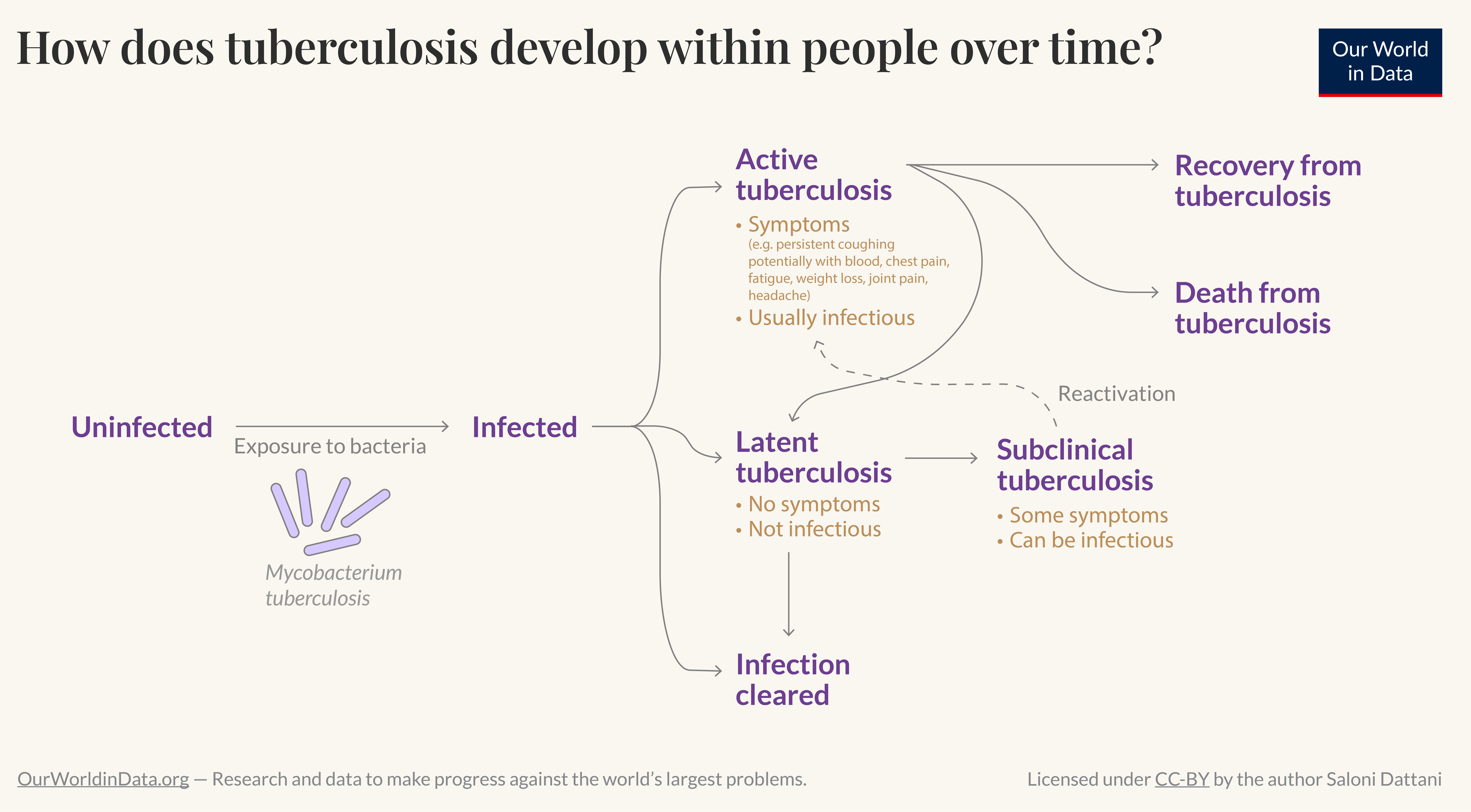Tuberculosis
Tuberculosis is one of the most common causes of death globally.
In richer countries, the impact of tuberculosis has been reduced significantly over history, but in poorer parts of our world, it continues to be a major challenge even today: it causes an estimated 1.2 million deaths annually.
Tuberculosis is caused by the bacteria Mycobacterium tuberculosis.
The bacteria spreads through respiratory particles and tends to cause tuberculosis in people with risk factors such as undernourishment, HIV/AIDS, smoking, and existing chronic conditions.
The disease involves symptoms like coughing, fatigue and night sweats, and can damage the lungs, the brain, kidneys and other organs, which can be fatal.
But it is treatable with a combination of specific antibiotics. Without being diagnosed correctly, however, people do not receive the proper treatment. This leaves them vulnerable, and also increases the risk that antibiotic-resistant strains of the bacteria will develop, which are much more difficult and expensive to treat.
With greater effort to tackle its risk factors and improve testing and treatment for the disease, the world can relegate tuberculosis to history — not just in the richer parts of the world, but for everyone.
On this page, you will find global data and trends on tuberculosis, including testing, treatment, and vaccination.
Endnotes
Floyd, K., Glaziou, P., Zumla, A., & Raviglione, M. (2018). The global tuberculosis epidemic and progress in care, prevention, and research: An overview in year 3 of the End TB era. The Lancet Respiratory Medicine, 6(4), 299–314. https://doi.org/10.1016/S2213-2600(18)30057-2
Fukunaga, R., Glaziou, P., Harris, J. B., Date, A., Floyd, K., & Kasaeva, T. (2021). Epidemiology of Tuberculosis and Progress Toward Meeting Global Targets—Worldwide, 2019. MMWR. Morbidity and Mortality Weekly Report, 70(12), 427–430. https://doi.org/10.15585/mmwr.mm7012a4
Glaziou, P., Floyd, K., & Raviglione, M. (2018). Global Epidemiology of Tuberculosis. Seminars in Respiratory and Critical Care Medicine, 39(03), 271–285. https://doi.org/10.1055/s-0038-1651492
Esmail, H., Barry, C. E., Young, D. B., & Wilkinson, R. J. (2014). The ongoing challenge of latent tuberculosis. Philosophical Transactions of the Royal Society B: Biological Sciences, 369(1645), 20130437. https://doi.org/10.1098/rstb.2013.0437
Horton, K. C., Richards, A. S., Emery, J. C., Esmail, H., & Houben, R. M. G. J. (2023). Reevaluating progression and pathways following Mycobacterium tuberculosis infection within the spectrum of tuberculosis. Proceedings of the National Academy of Sciences, 120(47), e2221186120. https://doi.org/10.1073/pnas.2221186120
Migliori, G. B., & Raviglione, M. C. (Eds.). (2021). Essential Tuberculosis. Springer International Publishing. https://doi.org/10.1007/978-3-030-66703-0
Shah, M., & Dorman, S. E. (2021). Latent Tuberculosis Infection. New England Journal of Medicine, 385(24), 2271–2280. https://doi.org/10.1056/NEJMcp2108501
Zellweger, J. P., Sotgiu, G., Corradi, M., & Durando, P. (2020). The diagnosis of latent tuberculosis infection (LTBI): Currently available tests, future developments, and perspectives to eliminate tuberculosis (TB): The diagnosis of latent tuberculosis infection (LTBI). La Medicina Del Lavoro | Work, Environment and Health, 111(3), 170–183. https://doi.org/10.23749/mdl.v111i3.9983
Churchyard, G., Kim, P., Shah, N. S., Rustomjee, R., Gandhi, N., Mathema, B., Dowdy, D., Kasmar, A., & Cardenas, V. (2017). What We Know About Tuberculosis Transmission: An Overview. The Journal of Infectious Diseases, 216(suppl_6), S629–S635. https://doi.org/10.1093/infdis/jix362
Mathema, B., Andrews, J. R., Cohen, T., Borgdorff, M. W., Behr, M., Glynn, J. R., Rustomjee, R., Silk, B. J., & Wood, R. (2017). Drivers of Tuberculosis Transmission. The Journal of Infectious Diseases, 216(suppl_6), S644–S653. https://doi.org/10.1093/infdis/jix354
In addition, some people who have had active tuberculosis can then develop latent tuberculosis, which can later reactivate again, causing a recurrence of the disease.
Rates of tuberculosis also tend to be higher among adults.
Amere, G. A., Nayak, P., Salindri, A. D., Narayan, K. M. V., & Magee, M. J. (2018). Contribution of Smoking to Tuberculosis Incidence and Mortality in High-Tuberculosis-Burden Countries. American Journal of Epidemiology, 187(9), 1846–1855. https://doi.org/10.1093/aje/kwy081
Bell, L. C. K., & Noursadeghi, M. (2018). Pathogenesis of HIV-1 and Mycobacterium tuberculosis co-infection. Nature Reviews Microbiology, 16(2), 80–90. https://doi.org/10.1038/nrmicro.2017.128
Bruchfeld, J., Correia-Neves, M., & Källenius, G. (2015). Tuberculosis and HIV Coinfection. Cold Spring Harbor Perspectives in Medicine, 5(7), a017871. https://doi.org/10.1101/cshperspect.a017871
Uden, L., Barber, E., Ford, N., & Cooke, G. S. (2017). Risk of Tuberculosis Infection and Disease for Health Care Workers: An Updated Meta-Analysis. Open Forum Infectious Diseases, 4(3), ofx137. https://doi.org/10.1093/ofid/ofx137
Schrager, L. K., Vekemens, J., Drager, N., Lewinsohn, D. M., & Olesen, O. F. (2020). The status of tuberculosis vaccine development. The Lancet Infectious Diseases, 20(3), e28–e37. https://doi.org/10.1016/S1473-3099(19)30625-5
Migliori, G. B., & Raviglione, M. C. (Eds.). (2021). Essential Tuberculosis. Springer International Publishing. https://doi.org/10.1007/978-3-030-66703-0
This is especially a problem for tuberculosis because many treatments for the disease need to be taken for several months. This is for two reasons: the bacteria have more time to develop resistance, and it makes it more likely that people do not continue to follow the prescriptions, which makes it easier for bacteria to develop resistance.
Lange, C., Dheda, K., Chesov, D., Mandalakas, A. M., Udwadia, Z., & Horsburgh, C. R. (2019). Management of drug-resistant tuberculosis. The Lancet, 394(10202), 953–966. https://doi.org/10.1016/S0140-6736(19)31882-3
Gygli, S. M., Borrell, S., Trauner, A., & Gagneux, S. (2017). Antimicrobial resistance in Mycobacterium tuberculosis: Mechanistic and evolutionary perspectives. FEMS Microbiology Reviews, 41(3), 354–373. https://doi.org/10.1093/femsre/fux011
World Health Organization. (2015). The end TB strategy. https://web.archive.org/web/20231214163433/https://iris.who.int/bitstream/handle/10665/331326/WHO-HTM-TB-2015.19-eng.pdf
World Health Organization (2019). WHO consolidated guidelines on drug-resistant tuberculosis treatment. Available online. https://iris.who.int/bitstream/handle/10665/311389/9789241550529-eng.pdf
Kendall, E. A., Sahu, S., Pai, M., Fox, G. J., Varaine, F., Cox, H., Cegielski, J. P., Mabote, L., Vassall, A., & Dowdy, D. W. (2019). What will it take to eliminate drug-resistant tuberculosis? The International Journal of Tuberculosis and Lung Disease, 23(5), 535–546. https://doi.org/10.5588/ijtld.18.0217
Bell, L. C. K., & Noursadeghi, M. (2018). Pathogenesis of HIV-1 and Mycobacterium tuberculosis co-infection. Nature Reviews Microbiology, 16(2), 80–90. https://doi.org/10.1038/nrmicro.2017.128
Bruchfeld, J., Correia-Neves, M., & Källenius, G. (2015). Tuberculosis and HIV Coinfection. Cold Spring Harbor Perspectives in Medicine, 5(7), a017871. https://doi.org/10.1101/cshperspect.a017871
HIV/AIDS makes people vulnerable to multiple diseases which can be fatal, including tuberculosis.
Typically, in international statistics, “tuberculosis deaths” refers to deaths in HIV-negative people, while tuberculosis deaths among people with HIV are classified under “HIV/AIDS related deaths”.
Here, the composition of HIV/AIDS related deaths are broken down to better understand the impact of tuberculosis among people with HIV/AIDS.
The BCG vaccine’s efficacy varies between locations and is generally found to be more effective in countries far from the equator.
This is likely due to a range of factors, such as different strains of Mycobacterium tuberculosis around the world; exposure to other mycobacteria in the environment, which can affect the immune system’s response to the vaccine; and other factors.
Cirillo, D. M., Ghodousi, A., & Tortoli, E. (2021). Mycobacterium tuberculosis: The Organism’s Genomics and Evolution. In G. B. Migliori & M. C. Raviglione (Eds.), Essential Tuberculosis (pp. 11–17). Springer International Publishing. https://doi.org/10.1007/978-3-030-66703-0_2
Fatima, S., Kumari, A., Das, G., & Dwivedi, V. P. (2020). Tuberculosis vaccine: A journey from BCG to present. Life Sciences, 252, 117594. https://doi.org/10.1016/j.lfs.2020.117594
Kuan, R., Muskat, K., Peters, B., & Lindestam Arlehamn, C. S. (2020). Is mapping the BCG vaccine‐induced immune responses the key to improving the efficacy against tuberculosis? Journal of Internal Medicine, 288(6), 651–660. https://doi.org/10.1111/joim.13191
In addition, children who suffer from HIV are not recommended to take the BCG vaccine.
Carvalho, A. C. C., Cardoso, C. A. A., Martire, T. M., Migliori, G. B., & Sant’Anna, C. C. (2018). Epidemiological aspects, clinical manifestations, and prevention of pediatric tuberculosis from the perspective of the End TB Strategy. Jornal Brasileiro de Pneumologia, 44(2), 134–144. https://doi.org/10.1590/s1806-37562017000000461
Swaminathan, S., & Rekha, B. (2010). Pediatric Tuberculosis: Global Overview and Challenges. Clinical Infectious Diseases, 50(s3), S184–S194. https://doi.org/10.1086/651490
Cite this work
Our articles and data visualizations rely on work from many different people and organizations. When citing this topic page, please also cite the underlying data sources. This topic page can be cited as:
Saloni Dattani, Fiona Spooner, Hannah Ritchie and Max Roser (2023) - “Tuberculosis” Published online at OurWorldInData.org. Retrieved from: 'https://ourworldindata.org/tuberculosis' [Online Resource]BibTeX citation
@article{owid-tuberculosis,
author = {Saloni Dattani and Fiona Spooner and Hannah Ritchie and Max Roser},
title = {Tuberculosis},
journal = {Our World in Data},
year = {2023},
note = {https://ourworldindata.org/tuberculosis}
}Reuse this work freely
All visualizations, data, and code produced by Our World in Data are completely open access under the Creative Commons BY license. You have the permission to use, distribute, and reproduce these in any medium, provided the source and authors are credited.
The data produced by third parties and made available by Our World in Data is subject to the license terms from the original third-party authors. We will always indicate the original source of the data in our documentation, so you should always check the license of any such third-party data before use and redistribution.
All of our charts can be embedded in any site.









































